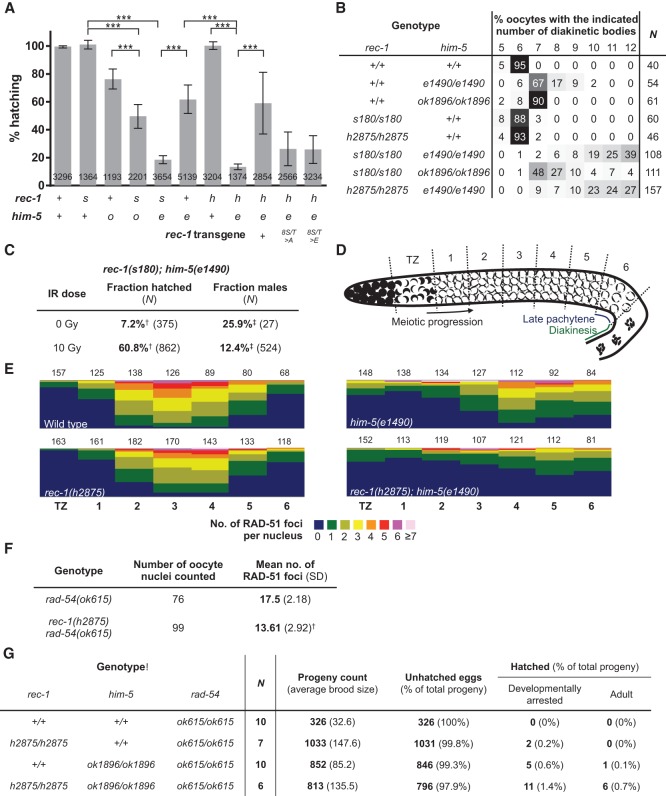Figure 5.
rec-1 and him-5 mutants interact genetically to alter the number of crossover events. (A) The rec-1; him-5 double mutants exhibit lower hatching frequency than the rec-1 and him-5 single mutants. Eggs laid by developmentally synchronized animals were collected in 24-h intervals, and the hatched progeny were counted 3 d later. (***) P < 0.0001 (Kruskal-Wallis nonparametric test). Values on the bars indicate the number of eggs counted for the specific genotype. The rec-1 genotypes used were wild type (+), s180 (s), h2875 (h), a phospho-mutant allele (8S/ T> A), and a phospho-mimetic allele (8S/T > E). The him-5 genotypes used were wild type (+), ok1896 (o), and e1490 (e). (B) rec-1 and him-5 mutations act synergistically to increase the number of 4′,6-diamidino-2-phenylindole (DAPI)-staining structures in the diakinetic oocyte. For added clarity, cells in the table are shaded on a gradient—0 (white) to 100 (black)—based on value. (N) Number of oocytes assayed. (C) Consistent with a lack of meiotic crossovers, the fraction of hatched rec-1(s180); him-5(e1490) embryos increased, and the fraction of spontaneous rec-1; him-5 male progeny decreased by treatment with ionizing radiation, an exogenous source of DSBs that can promote crossovers in the absence of SPO-11 function (Dernburg et al. 1998). (†) The difference is statistically significant (P ≈ 4.9 × 10−68, χ2-test); (‡) the difference is statistically significant (P ≈ 0.042, χ2-test). (D) Schematic of the C. elegans germline showing regions in which RAD-51 foci were quantified in individual nuclei. (E) Quantification of the percentage of nuclei (Y-axis) in each region shown in D (X-axis) with the number of RAD-51 foci (revealed as a heat map showing the range of foci from 0 to 7). Numbers above each stacked bar indicate the numbers of nuclei examined per region from TZ through zone 6. Two gonad arms were analyzed for each genotype. (F) A loss of function in rec-1 reduces the total number of DSBs in late pachytene nuclei, as assayed by RAD-51 staining in rad-54(ok615) mutants, which cannot process meiotic DSBs into recombination intermediates. (†) The reduction compared with rad-54(ok615) is significant (P < 0.0001, two-tailed Student's t-test). (G) Mutations in rec-1, him-5, or both rescue the maternal-effect embryonic-lethal phenotype of rad-54(ok615) in two ways: by increasing the number of eggs laid (“progeny count”) and by increasing the proportion of eggs that hatch into either developmentally arrested larvae (“developmentally arrested”) or larvae that eventually grow into adult animals (“adult”). Both effects are consistent with the decreased number of DSBs in the rec-1, him-5, or double-mutant genetic background.

